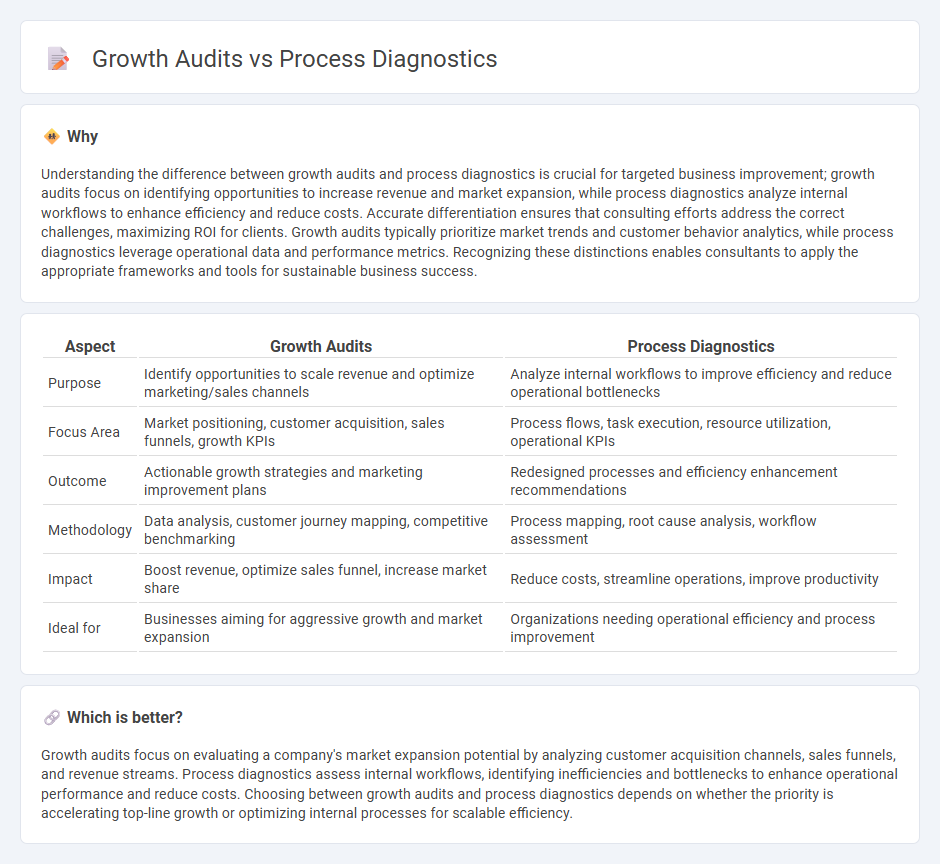
Growth audits evaluate a company's key performance indicators, customer acquisition channels, and revenue streams to identify scalable opportunities for expansion. Process diagnostics analyze internal workflows, resource allocation, and operational bottlenecks to enhance efficiency and reduce costs. Discover how combining these approaches can accelerate your business transformation.
Why it is important
Understanding the difference between growth audits and process diagnostics is crucial for targeted business improvement; growth audits focus on identifying opportunities to increase revenue and market expansion, while process diagnostics analyze internal workflows to enhance efficiency and reduce costs. Accurate differentiation ensures that consulting efforts address the correct challenges, maximizing ROI for clients. Growth audits typically prioritize market trends and customer behavior analytics, while process diagnostics leverage operational data and performance metrics. Recognizing these distinctions enables consultants to apply the appropriate frameworks and tools for sustainable business success.
Comparison Table
| Aspect | Growth Audits | Process Diagnostics |
|---|---|---|
| Purpose | Identify opportunities to scale revenue and optimize marketing/sales channels | Analyze internal workflows to improve efficiency and reduce operational bottlenecks |
| Focus Area | Market positioning, customer acquisition, sales funnels, growth KPIs | Process flows, task execution, resource utilization, operational KPIs |
| Outcome | Actionable growth strategies and marketing improvement plans | Redesigned processes and efficiency enhancement recommendations |
| Methodology | Data analysis, customer journey mapping, competitive benchmarking | Process mapping, root cause analysis, workflow assessment |
| Impact | Boost revenue, optimize sales funnel, increase market share | Reduce costs, streamline operations, improve productivity |
| Ideal for | Businesses aiming for aggressive growth and market expansion | Organizations needing operational efficiency and process improvement |
Which is better?
Growth audits focus on evaluating a company's market expansion potential by analyzing customer acquisition channels, sales funnels, and revenue streams. Process diagnostics assess internal workflows, identifying inefficiencies and bottlenecks to enhance operational performance and reduce costs. Choosing between growth audits and process diagnostics depends on whether the priority is accelerating top-line growth or optimizing internal processes for scalable efficiency.
Connection
Growth audits and process diagnostics are interconnected through their focus on identifying inefficiencies and opportunities for optimization within a business. Growth audits analyze key performance indicators and market positioning to uncover barriers to scaling, while process diagnostics examine internal workflows and operational procedures to enhance productivity. Combined, they provide a comprehensive approach to diagnosing challenges and implementing targeted strategies that drive sustainable business growth.
Key Terms
Root Cause Analysis
Process diagnostics identify inefficiencies and bottlenecks within workflows by analyzing data trends and operational metrics, enabling targeted improvements. Growth audits evaluate marketing and sales strategies, measuring performance indicators such as conversion rates, customer acquisition costs, and retention metrics to uncover underlying issues impacting expansion. Explore comprehensive strategies to differentiate and apply root cause analysis for both process optimization and growth acceleration.
Opportunity Assessment
Process diagnostics identify inefficiencies and bottlenecks within operational workflows, using data-driven methods to pinpoint areas limiting productivity and quality. Growth audits evaluate market positioning, customer acquisition strategies, and revenue streams to uncover untapped potential for scaling and expansion. Explore comprehensive opportunity assessment techniques to enhance both operational excellence and strategic growth potential.
Performance Metrics
Process diagnostics analyze operational workflows to identify inefficiencies and bottlenecks impacting overall productivity, emphasizing key performance indicators (KPIs) such as cycle time, defect rates, and resource utilization. Growth audits evaluate marketing strategies and sales funnels to measure customer acquisition, retention rates, and revenue growth metrics, highlighting areas of opportunity for scaling. Explore detailed methodologies and tailored frameworks to enhance your business's performance metrics effectively.
Source and External Links
Process-Oriented Diagnostics: Principles, Practice, Community ... - Process-oriented diagnostics (PODs) provide feedback for model developers by characterizing physical processes related to model simulation accuracy, helping identify and improve specific processes within climate and weather models through detailed physical hypothesis testing.
300mm Process Diagnostics and Control Products - Advanced in-line process diagnostics systems like Excite 300mm enable rapid, high-sensitivity detection of particles and defects on wafers during semiconductor manufacturing, facilitating quick root cause identification and process control in high-volume production.
Process diagnostics benefits for manufacturers - Control Engineering - Process diagnostics improve plant operation by providing local diagnostic information that accelerates issue identification and resolution beyond what centralized control systems like PLC and HMI can typically offer, thus reducing installation, commissioning, and maintenance time.
 dowidth.com
dowidth.com